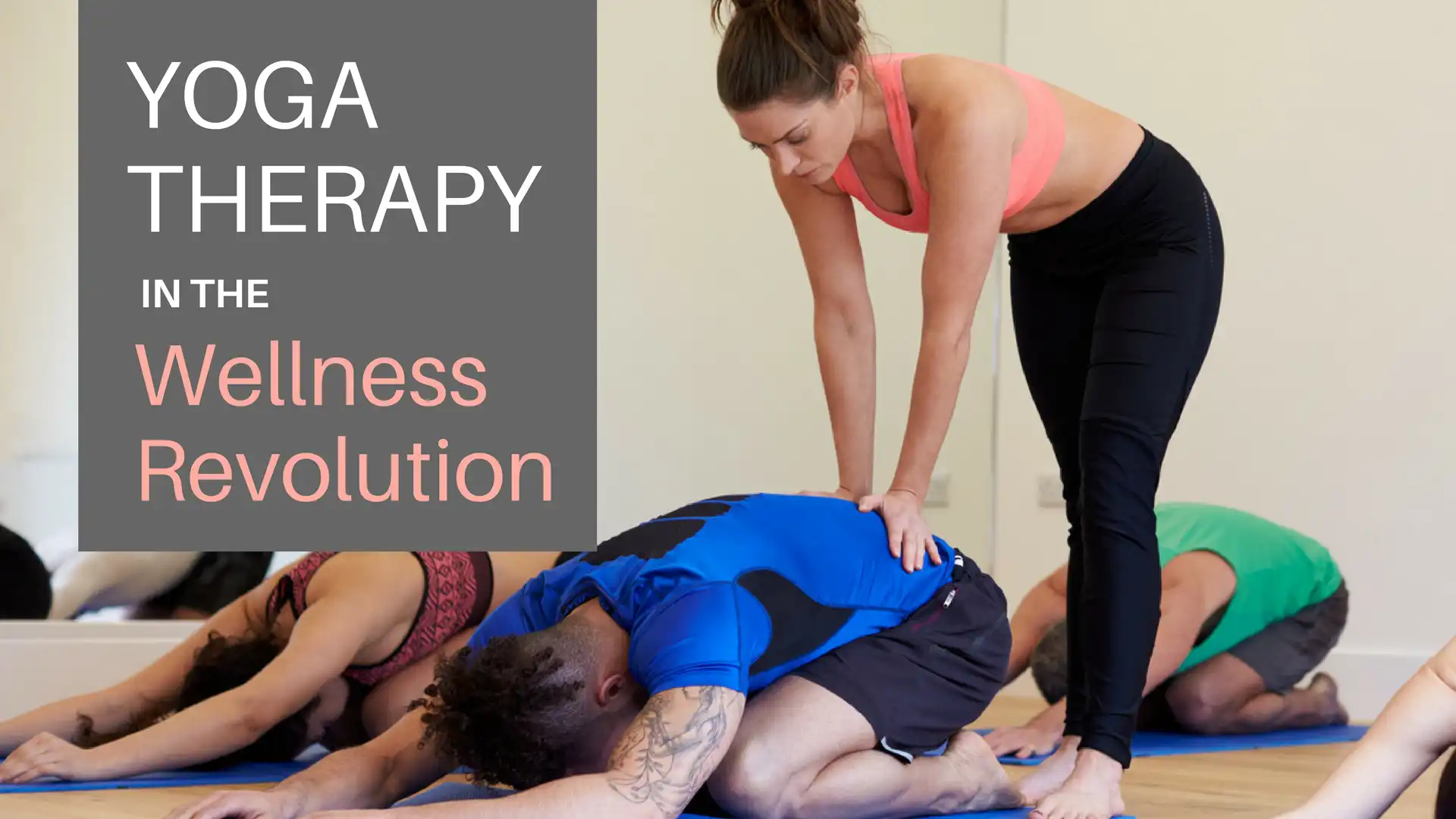Yoga and Yoga Therapy in the Wellness Revolution — Tapping Into Vast New Teaching Opportunities

Article At A Glance
By Eva Norlyk Smith, Ph.D., C-IAYT, and Terry Smith, Ph.D., C-IAYT
This article first appeared in the International Journal of Yoga Therapy, Volume 18, Issue 1.
The need for yoga therapists – or yoga teachers, who can address the needs of wellness seekers and older beginners is growing daily, and it’s safe to say that these groups represent the most significant untapped opportunity for yoga teachers and yoga therapists. Yoga teachers and therapists can offer something unique and sorely needed in our healthcare system to significantly contribute to the wellness revolution.
The role of yoga and yoga therapy in the wellness revolution has received little attention in the ongoing discussion about how to best develop a yoga therapy profession. Much discussion has centered on how yoga therapy can help people with a diagnosed illness. This implicitly defines yoga therapy as an emerging, complementary disease-care modality. This may derive from the assumption that yoga teachers focus on wellness, whereas yoga therapists focus on alleviating or providing complementary treatment for disorders.
Yet, as we will argue in this article, focusing too narrowly on yoga therapy as treatment will cause us to overlook key characteristics of the clients most likely to seek out yoga therapy. Understanding the current and future needs of the people likely to drive the demand for yoga therapy is critical to determining what yoga therapists will most likely be called on to offer and, consequently, what training will be needed.
Yoga and the Wellness Movement

The wellness movement is one of the most significant sociological trends of the 21st century. It has been primarily a grass-roots movement driven by consumers seeking to take charge of their health and well-being. The movement represents a massive shift in how many Americans approach health and prevention. This shift is apparent in everything from the growing interest in healthier foods and supplements to the increasing demand for fitness and weight-loss services and the surge of interest in holistic and alternative approaches to healthcare and prevention, including yoga.
The wellness movement is defined more by consumer demand than any underlying philosophical tradition. In the five years from 2002 to 2007, the wellness industry grew from a $200 billion to $500 billion, and it is now a $3.72 trillion industry- far exceeding early projections.[1] In comparison, the medical industry was a $3 trillion industry in 2012.
Who Drives the Wellness Movement?
Wellness-seeking consumers seek alternatives to the disease-care model and its emphasis on after-the-fact treatment of disease. The demand is not only for ways to help one stay physically healthy but also to optimize mental, emotional, and spiritual well-being. In the book The Wellness Revolution, author Paul Zane Pilzer succinctly articulates this difference:
- The sickness business is reactive. Despite its enormous size, people become customers only when they are stricken by and react to a specific condition or complaint… [T]he wellness business is proactive. People voluntarily become customers—to feel healthier, reduce aging effects, and avoid becoming customers of the sickness business.[2]
The wellness movement has much in common with yoga in its goals, objectives, and emphasis on optimizing well-being. Consider, for example, this definition of wellness proposed by John Travis, MD, MPH (and notice how easily the word “yoga” could be substituted for “wellness” ):
- Wellness is a choice—a decision you make to move toward optimal health. Wellness is a way of life—a lifestyle you design to achieve your highest potential for well-being. Wellness is a process—a developing awareness that there is no end point but that health and happiness are possible in each moment, here and now. Wellness is the integration of body, mind, and spirit—the appreciation that everything you do, think, feel, and believe impacts your state of health.[3]
Wellness seekers, in short, are driven by a quest similar to that of the ancient Yogis—the search for ways to experience one’s highest well-being potential, a state of integration of body, mind, and spirit. They are also driven by the more mundane desire to feel good, to stay healthy and well-functioning as long as possible, and to be proactive about their health rather than relying on the after-the-fact crisis intervention of mainstream medicine.
Yoga Wellness vs. Yoga Therapy? The Health–Illness Continuum

To deepen our understanding of what yoga therapy offers in the context of the wellness revolution, it is helpful to consider the concept of the health-illness continuum. Health is often conceptualized in absolute terms: a person is either healthy or sick. Health and illness are not absolutes, however. They exist along a continuum. There are levels of health, as well as there are levels of disease, ranging from minor ailments to severe illness and death.
On the far side of the health-illness continuum is a state of complete balance of body, mind, and spirit, an integrated form of emotional balance and wellness. Toward the middle are people considered to be in good health but without the vital, vibrant, and enthusiastic excitement about life associated with wellness as “progress toward an ever-higher potential of functioning.” [4] Toward the illness range of the continuum, we find people who, medically speaking, are not really “sick” but who still suffer from minor complaints, be it occasional headaches, musculoskeletal pains, irritability, mood swings, insomnia, digestive disturbances, high blood pressure, and so on. At the illness range of the continuum, of course, are people with clinical disorders ranging from moderate to severe and life-threatening diseases.
Allopathic practitioners cater to people in the illness range of the continuum. The people fueling the demand for wellness services, and in particular yoga and yoga therapy, on the other hand, fall in the full range of the spectrum. The reasons people seek out yoga and yoga therapy can be placed along a similar continuum, roughly grouped as follows:
- People in good health, seeking to optimize well-being. These individuals want to achieve a higher degree of wellness and self-actualization, whether by enhancing physical fitness or mental, emotional, or spiritual well-being.
- People in good health, seeking to maintain health. These individuals seek to adopt healthy lifestyle choices as a means to stay healthy, to lose weight, and to age well.
- People with minor health issues seeking to improve their health. These individuals are dealing with minor complaints, whether mental/emotional (e.g., stress management, minor depression) or physical (e.g., back pain, joint stiffness, reduced mobility).
- People with an illness. These individuals seek additional ways to manage or get help with disease conditions for which allopathic medicine is not providing satisfactory solutions.
The term “therapy” implies “treatment” or “cure” of an illness and ailment. As a result, it’s easy to approach yoga therapy as if it is yet another, albeit more comprehensive, treatment modality to be added to the medical menu of options. In this, however, we risk ignoring the very people most likely to seek out yoga therapy services.† According to one survey, 64% of people who begin yoga practice did so to increase wellness, compared to 48% for health conditions and 21% for back and neck pain issues.[5] The survey gives a good indication of how many people who come to yoga fall into categories 1 through 3, seeking enhanced wellness or relief for only minor health issues.
Yoga Therapy and the “Worried Well”

Mainstream medicine has little to offer people who are not well yet without any diagnosable disease. These are the people that fall in category three on the above model. This is not a small group of people—patients with “no diagnosable disorder” constitute an estimated 60 percent of all medical visits.
This group is often derisively referred to as the “worried well” by mainstream medicine.[6] The implicit assumption appears to be that if a condition can’t be diagnosed within the framework of existing medical knowledge, it doesn’t exist. Traditionally, these people were told, “It’s all in your head.” Today, they are more likely to be labeled with some category of mild psychiatric disorder and prescribed drugs to dull the somatic or emotional pain underlying their symptoms.
However, inherent in the model of the health-illness continuum (as well as in the Ayurvedic model) is the idea that disease develops gradually, showing up first as subclinical imbalances. If these imbalances are not addressed, the individual eventually progresses into a state of diagnosable disease. People moving from the middle of the continuum toward the illness end may exhibit only minor symptoms.
While any well-trained yoga teacher will focus on giving students the experience of wellness, most yoga teachers at the 200-hour level are only trained to deal with people who fall in category one and, to some extent, category 2. Yet a large proportion of people seeking out yoga fall in categories 2 and 3, the “worried well.” In many cases, the wellness needs of this group of people go beyond what most 200-hour yoga teachers have been trained to deliver. These individuals are turning to yoga to deal with minor health issues—and, in the future, will turn to yoga to deal with issues related to typical aging. This will increasingly be the case as the population that launched the wellness revolution moves from middle age towards the senior years.
The most significant upsurge in the demand for wellness services—and yoga therapy—is unfolding as we speak. A tsunami of baby boomers is heading from middle age towards their senior years, doubling the senior population in more than half the states in the country over the next two decades. These are the very people—predominantly female baby boomers—who fueled the yoga boom and the wellness movement to begin with.[7] They are determined to redefine aging, as boomers have redefined any other stage of life they have been through. This group will likely fuel much of the consumer-driven demand for yoga therapy going forward. The future wellness needs of this group should be considered when defining yoga therapy and the requirements for yoga therapist training.
The Wellness Revolution and Yoga Therapist Training
Defining what yoga therapy is and what yoga therapist training should include is difficult because yoga is a diverse body of knowledge. Unlike the field of osteopathy or chiropractic, yoga does not offer a specific set of techniques to apply to particular problems. Indeed, it runs counter to the holistic nature of yoga to try to universally prescribe specific postures for specific issues.
Yet, complying with health insurance requirements in a clinical setting would, more often than not, necessitate using a standardized protocol of postures to “fix” specific problems, much like physical therapists do now. While targeting postures toward specific issues has obvious value, yoga, as any teacher knows, works its true magic holistically, multi-dimensionally, and unpredictably. Yoga is rarely, if ever, a quick fix for a specific problem. Yet, that is the box that is courting the medical model of yoga therapy as a complementary treatment modality would force us into.
Fashioning yoga therapy and yoga therapist training after the fix-it treatment model offered by allopathic medicine divorces us from yoga’s essence—and the therapeutic value. If we pursue that direction, we risk creating a brand of yoga therapy designed according to the requirements needed for insurance coverage. It would not constitute yoga therapy molded to meet our clients’ actual needs.
Instead, attending to the demands of wellness-seeking clients forces us to celebrate and cultivate what is genuinely unique about yoga as therapy. It reframes the discussion about what yoga therapy is from questions about how to gain acceptance as a treatment modality within the medical framework toward aligning it with the needs of the demographic force that has created the yoga boom and will drive the demand for yoga therapy going forward.
Different Model, Different Questions

If we aim to train yoga therapists who will best serve the needs of aging boomers and wellness seekers, it forces us to ask entirely different questions:
- How can we best give clients the knowledge, techniques, and tools they need to manage their health maintenance and prevention?
- What unique contributions does yoga bring to the ongoing discussion within the wellness community about how to help people make behavioral lifestyle changes that foster better long-term health?
- How can yoga therapy serve to foster aging that is not characterized by fading vitality and declining health?
- How do we keep the life force flowing fully, nourishing, and freely, even as the body ages?
- How do we serve the wellness needs of people who want to be proactive about dealing with minor ailments (musculoskeletal pain, insomnia, stress, anxiety, high blood pressure, non-clinical depression, headaches, fatigue, and so on)?
- What types of therapeutic yoga training would be required to serve the needs of wellness-seeking individuals?
The need for yoga therapists – or yoga teachers, who can address the needs of wellness seekers and older beginners is growing daily, and it’s safe to say that these groups represent the most significant untapped opportunity for yoga teachers and yoga therapists. However, unless we take steps to answer the above questions and other similar questions, we will not be able to develop both yoga teaching and yoga therapy as professions that effectively serve the needs of what will continue to be the most significant potential audience for our services.
Conclusion about Yoga Therapy and The Wellness Revolution
[1]Yoga therapy has the potential to provide its greatest contribution, whereas mainstream medicine fails most pitifully. We offer something truly unique—and something sorely needed in a malfunctioning healthcare system that is bogged down by acute intervention in late-stage disease that could, in most cases, have been prevented.
If we believe our principles—that enlivenment and awareness dawns from the inside, that yoga fosters healing, integration, and balance of mind and body from the inside, then the discussion about how to advance yoga therapy as a modality to meet the unmet wellness needs of the population—not as a disease care modality—must take center stage.
References
[1] Zane Pilzer, P. The New Wellness Revolution. New York: John Wiley & Sons; 2007.
[2] Pilzer, P Zane, The Wellness Revolution. New York: John Wiley & Sons; 2002, p. 4.
[3] Travis, JW and Regina, SR. The Wellness Workbook—How to Achieve Lasting Health and Vitality. Celestial Arts; 1988)
[5] Saper RB, Eisenberg DM, Davis RB, Culpepper L, Phillips RS. Prevalence and patterns of adult yoga use in the United States: results of a national survey. Alternative Therapies in Health and Medicine 2004; Mar-Apr;10(2):44-9.
[6] Diamond, F. How To Manage the Worried Well. Managed Care, June 2003.
[7] Zane Pilzer, P. The Wellness Revolution. New York: John Wiley & Sons; 2002.



